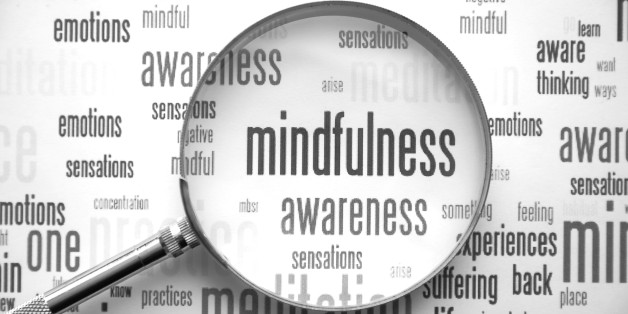By Cheryl Jones, Aetna Mindfulness Strategy Lead, MBSR trained
While mindfulness has been a hot topic, we’ve struggled with both offering an understandable definition and demonstrating its practical application for modern life. There are numerous scientific publications on mindfulness. We’ve known for a long time that mindfulness reduces stress. We now know it can change our brains. Mindfulness is about full awareness of the present moment, the one we’re in right now, with a gentle and open mind. I hope this article will help debunk some of the myths and confusion around mindfulness. I hope you’ll see that mindfulness is really for all of us and there’s no one way to practice it. In fact, I hope 2016 will be the year we think less about mindfulness, and practice it more.
1. Mindfulness and mindfulness meditation are one and the same.
Actually, no. Mindfulness can be practiced in two ways; formally through mindfulness meditation and informally during the daily events of our lives.
Formal mindfulness meditation is practiced through sitting meditation, walking meditation, lying down meditation (body scan) and mindful yoga. This can be done for 10-30 minutes.
Informal mindfulness practice is about pausing and noticing what’s happening within us and around us as we go through the tasks of the day. We note breathing, thoughts, feelings, sensations, and surroundings. Rather than a mental checklist, we do this with gentle, non-judgmental awareness.
2. We need to be present in the moment all the time.
Keep reading. It isn’t a goal of mindfulness to be present in each and every moment. If we did this, we’d be overstimulated and overwhelmed. We need a dose of distraction sometimes. When we’re processing strong emotions, we need a break from them. We need to allow the mind to wander. This helps us think out of the box and be creative.
With mindfulness, we notice when we’re distracted and what has drawn our attention away from the present moment. We consciously choose if we want to stay in that place of distraction or come back to what’s happening in the present moment. Mindfulness practice helps us filter out irrelevant information so we can be more effective.
3. Mindfulness is about deep breathing.
Not quite. Rather than concentrating on the breath, which implies effort, we’re simply aware that the body is breathing. There’s no particular technique. We don’t even need to take a deep breath. We don’t have to count. We don’t need a mantra. We don’t change or manipulate our breathing in any way.
We discover that our breathing has texture. It may be shallow or choppy — long or smooth. Next, we notice where we feel our breathing — at the nostrils, chest, or abdomen. We simply allow our attention to rest wherever we feel our breathing the most and gently ride the waves of our breathing. While mindfulness is much more than awareness of the breath, we consider this home base. The breath is the anchor to the present moment.
4. Mindfulness meditation is about having a quiet mind.
There’s a bit more to it! Many people think they’re doing something wrong because they can’t clear their mind. In mindfulness meditation we don’t try to block out thoughts. Rather, we acknowledge them parading through the mind one by one. We notice what’s drawn our attention away from the present moment and then gently come back to the breath.
The mind is constantly thinking thoughts about the future or the past. We’re typically worrying, problem solving, planning, remembering, fantasizing, and playing old tapes from the past. With mindfulness meditation we discover the thoughts that deplete our energy, put us in a bad mood, and keep us up at night.
5. The goal of mindfulness meditation is to achieve a blissful state.
This isn’t entirely accurate. In mindfulness meditation there is no objective to achieve relaxation or some altered state of being. Mindfulness meditation involves a willingness to simply be with whatever is happening within us and around us — with a gentle and open mind.
We may discover things about ourselves, others, and the way we are living that aren’t working. This awareness can sometimes cause us to feel anxious at first. We may bump up against our past wounds; ones that often cause us to work too much, eat too much, drink too much, and self-medicate with alcohol, tobacco and prescription drugs.
Mindfulness requires courage to see things as they are rather than how we wish they were. We may need to engage in therapy or counseling to heal the inner conflicts and patterns that cause our suffering. The good news is that mindfulness practice helps us have the patience and compassion necessary for positive change.
6. Mindfulness is passive.
It’s certainly not. We’re in relationships with other people all day long. One of the many benefits of mindfulness is that we learn how to respond in stressful situations, rather than react. This means we consciously choose words and actions knowing they will impact another human being. Others are impacting us too. We may need to communicate how we feel about something or find a way to remove ourselves from a harmful situation.
Mindfulness builds healthy relationships through compassionate action — for ourselves and others. Mindfulness helps us ease suffering one conversation, one moment, one breath at a time. This practice is anything but passive.
This content is sponsored by Aetna. It is for general informational purposes only, and is not meant to replace the advice, diagnosis, or treatment of a physician or other health care professional.

Copyright © 2016 TheHuffingtonPost.com, Inc. | “The Huffington Post” is a registered trademark of TheHuffingtonPost.com, Inc.
